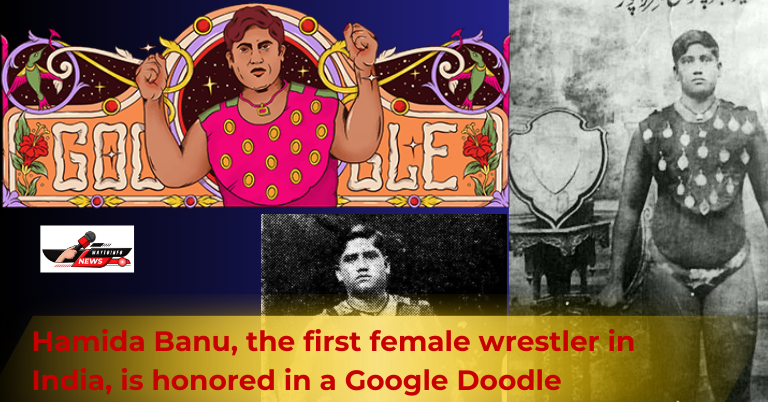The ‘Hamida Banu‘ Doodle commemorated the introduction of a woman into an Indian sport in the 1940s and 1950s that had previously been dominated by men.
On Saturday, May 4, Google Doodle honored Hamida Banu, India’s first professional woman wrestler. The Doodle served as a reminder of a female’s debut into a male-dominated sport throughout the 1940s and 1950s.
Defeat me in about, and I’ll agree to marry you.
Banu issued this challenge to male wrestlers in February 1954, according to BBC news reporting cited at the time.
Banu defeated two male wrestling champions shortly after the challenge, one from Punjab’s Patiala and the other from Kolkata, West Bengal, according to reports.
Hamida Banu traveled to Vadodara, Gujarat, in May for her third fight of the year. According to the BBC, Sudhir Parab, a Vadodara local, recalls the ensuing chaos from when Banu used to visit the city as a child. He recalled how posters and banners adorned trucks and other vehicles to announce her arrival. According to the narrative, newspapers hailed her as the “Amazon of Aligarh.”
Meanwhile, the wrestler Banu was slated to battle withdrew at the last minute, leaving Banu to face her next challenger, Baba Pahalwan.
On May 3, 1954, the Associated Press recounted the swift bout, lasting only one minute and 34 seconds, during which the woman triumphed with a decisive fall. Following this, the referee announced that Pahalwan was no longer within the realm of eligibility for marriage, as per the report.
What was the reason for Banu’s popularity?
The report highlighted that Hamida Banu’s weight, height, and dietary regimen were newsworthy topics. Allegedly, Banu weighed 108kg and stood at a height of 5ft 3in. Her daily intake reportedly comprised 5.6 litres of milk, 1.8 litres of fruit juice, 6 eggs, a fowl, 2.8 litres of soup, almost 1kg of mutton and almonds, half a kilo of butter, two substantial loaves of bread, two servings of biryani.
Author Maheshwar Dayal, in his 1987 book, depicted the widespread attraction surrounding Banu’s fame, noting how people from far-flung regions were drawn to witness her numerous bouts across Uttar Pradesh and Punjab.
In his 1987 book, Maheshwar Dayal portrayed the widespread allure of Banu’s fame, highlighting how individuals from distant areas were attracted to observe her numerous fights across Uttar Pradesh and Punjab.
During another instance, Banu encountered jeers and even became the target of stones thrown by fans after she triumphed over a male opponent. According to the newspaper, the police had to step in to control the unruly crowds.
In 1954, Banu achieved victory over Vera Chistilin, known as Russia‘s “female bear,” in a Mumbai bout that lasted less than a minute, as reported by the BBC, citing media sources. Additionally, she had plans to journey to Europe that same year to challenge wrestlers there.
tough personal circumstances
Quoting Feroz Shaikh, her grandson, the report revealed that Banu’s coach, Salam Pahalwan, opposed her decision to travel to Europe and attempted to deter her from doing so. According to her neighbor Rahil Khan, Banu suffered fractured legs after being beaten by her coach. “She was unable to stand. Although it eventually healed, for years she struggled to walk properly without a stick,” Rahil Khan was quoted as saying in the report.
Also Read: Rahul Gandhi
Sahara, the daughter of Salam Pahalwan, claimed that he had married Banu, whom she considered her stepmother. However, Banu’s grandson, Feroz Shaikh, held a different view. She did live with him, but they were never married, the report quoted Shaikh as saying.

